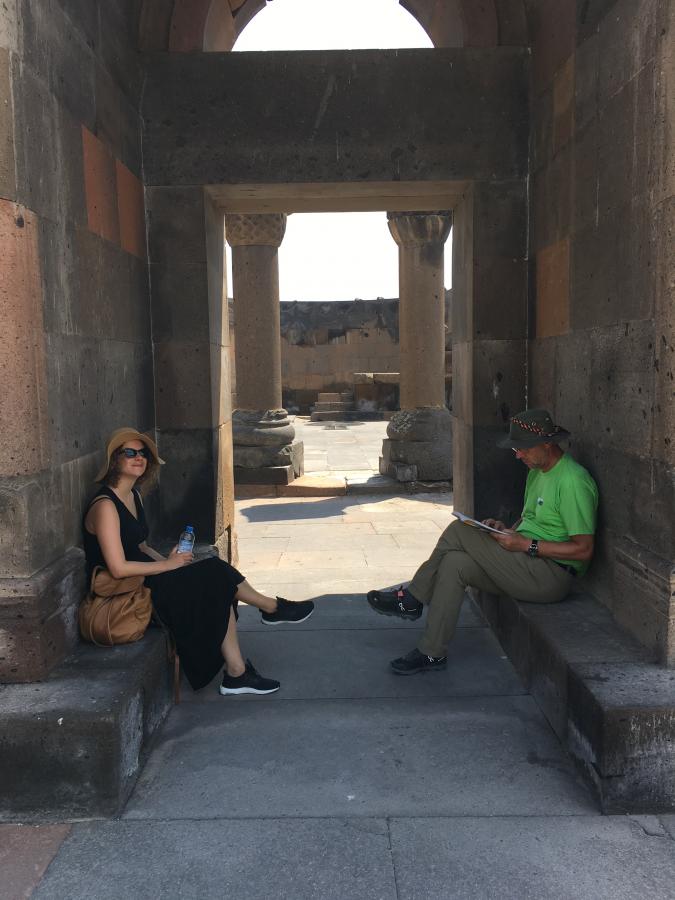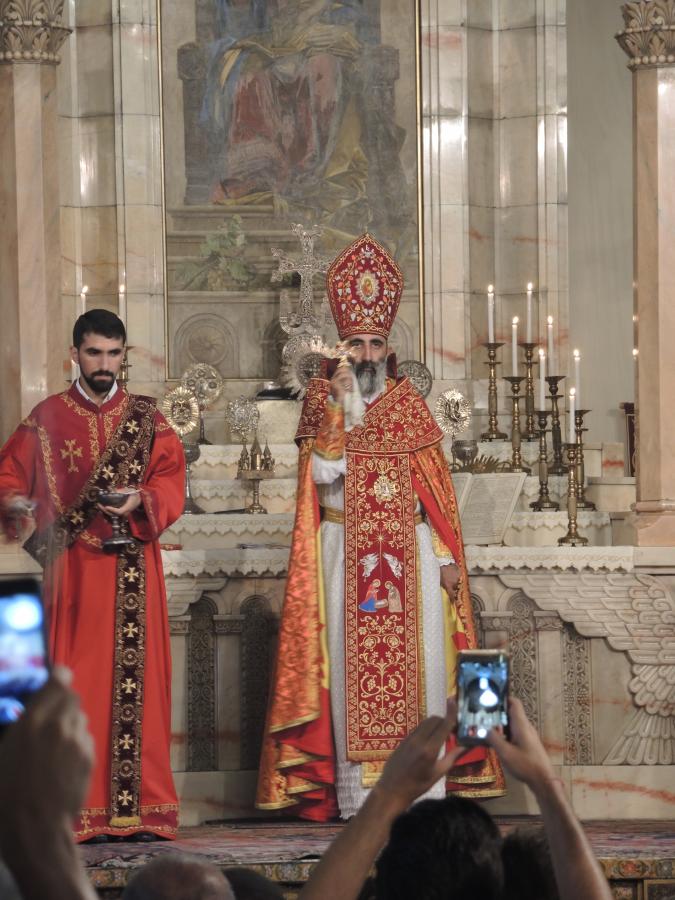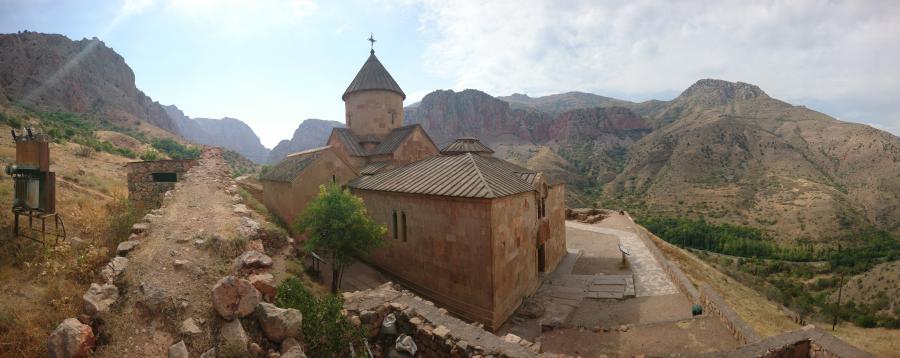Armenia
Oldest Christian country in the world
von 07.08.2017 bis 15.08.2017

A trip to Armenia begins for most visitors in the capital Yerevan. Not so for Heimo and me.
We come from the Iranian border, the Norduz Pass, to Armenia and are already excited about this, rather unknown country, which has a 3000 year old culture. The Armenian driver picked us up on time and after a 9-hour exhausting journey we finally catch sight of the lights of the capital Yerevan. Some of the mountain roads are in poor condition, and only allow slow, cautious driving.
For dinner we meet the rest of the Armenia tour group, led by my cousin Joschi and his wife Lena
(she is Armenian) is expertly supervised. We enjoy Chorovats, (an Armenian shashlik), and drink good wine grown in the country with it.
For the next few days there are some excursions on the program. For this we have organized an old minibus with driver.
The fascinating culture of Armenia is oriental influenced, but a deeply Christian one.
It is a land of churches and monasteries, a mountainous land, a land of stones that demands a lot from its inhabitants in its barrenness.
Sevan Lake – the blue pearl; the largest body of water in the country:
The 78 km long and 56 km wide lake lies at 1,900 m above sea level. It is fed by 20 rivers and has a water temperature of 22 degrees, which invites you to swim. We enjoy the wonderful refreshment. The ascent to Sevan Church, a church of the Apostles dating from 874, gives a magnificent view of the lake and the surrounding countryside.
Goshavankh Monastery – named after the Armenian scholar and poet Mechithar Gosh:
In 1181 the monastery was founded by him and within 30 years a number of buildings were erected, including
2 churches, several chapels and the monastery under his leadership. The library, built in 1291, is the heart of the monastery.
Mechithar Gosch was a great scholar and monk. He entertained and instructed the people with his fables.
The constitution of the first Armenian Code was also written by him.
Haghartsin Monastery – an important pagan place of worship even before its establishment:
We drive to Dilijan and further through densely overgrown forest area to the monastery, which has a varied, long history. The 100 inscriptions, placed on the walls of the monastery, tell about it. Through the generosity of a Sheikh of Sharjah, the monastery could be lavishly restored. Unfortunately, we cannot read the Armenian script. Their language is also spoken only in this country.
Hike to the Lasziver waterfalls:
After a three-hour drive from Yerevan, we reach our starting point of the hike. We still provide ourselves with fresh pita bread, cheese, tomatoes and a large watermelon. Heimo voluntarily carries them in his backpack, and nothing stands in the way of the picnic at the waterfalls. The hike leads through the forest again and again. We are grateful.
The thermometer has risen steadily and we are sweating profusely.
Wonderfully cool is then the air at the waterfall and we enjoy the nature.
Ararat – mythical mountain – in the shadow of Ararat the monastery Chor Virap:
The 5156 m high volcanic cone, always covered with snow, is a significant symbol for the Armenian people.
The view of the sublime mountain is stunning on a clear day from Yerevan.
We drive about 40 km from the capital towards Ararat as far as we are allowed and get very close to the mighty mountain. Barbed wire fences and the small watchtowers remind us that the holy mountain of Armenians is on Turkish territory.
The volcanic mountain can also be climbed only from Turkey.
Chor Virap Monastery is probably the most visited in Armenia near the Turkish border, guarded by the mighty Mount Ararat. The place is a popular place of pilgrimage and is inextricably linked with the legend of St. Grigor.
The pagan king is said to have put the Christian Grigor in a deep pit where he had to live inhospitably for 15 years. He was freed at the plea of a king’s daughter, who hoped that he could cure the king, who was suffering from a malignant disease.
Yerevan – a modern city of millions on the Hrazdan River and a memorial to the genocide:
The center of Jerevan and the most important buildings are best explored on foot.
The starting point for a tour of the city is Republic Square; past the Historical Museum, in front of which a large fountain with so-called singing fountains attracts people. A popular place, especially on balmy summer evenings when people can admire the water features. The Opera House is one of the most striking and beautiful buildings in the city. The art market offers besides the usual kitsch, countless Ararat pictures and also always works of art at low prices.
A climb up the cascades gives a beautiful view of the city.
The Armenian Genocide Memorial is an important place for people.
The gray basalt obelisk symbolizes the restoration of the Armenian people and commemorates the 1915 genocide.
1.5 million Armenians perished at that time. Every year on April 24 thousands of people gather here
and silently commemorate this terrible crime.
Garni the Sun Temple and the cave monastery Geghard:
After leaving behind the last modern houses and villas of Yerevan, we reach a plain high above the Azat River. We see the restored temple with its 24 columns and are impressed. King Trad I has already been here in the
1st c. A.D. had a temple built in the Greek, Roman style. The area is densely covered with walnut trees. The villagers sell fresh nut bread to the visitors. It tastes delicious.
At the end of the valley of the Azat Gorge is the Geghard Monastery, which we reach on foot via a small climb.
We feel the power place of the most popular place of pilgrimage in Armenia and marvel at the many wonderfully preserved testimonies of long Christian culture. Deep inside the rock, the cave-like monk cells have been built.
It was probably built in the 4th century. erected.
Edshmiatsin – center of spiritual life:
About 20 km west of Yerevan we visit the cathedral of Edshmiatsin, the most important religious center of Armenian Christianity and the seat of the Catholicos.
It is Sunday and a Mass celebration will be held at 11:00 a.m. with the religious leader joining in the celebration.
We are already there at 10:00 and can visit the beautiful church with the bell tower in peace.
At the beginning of the Mass celebration, the church fills to capacity. Solemnly, under the singing of the choir, the priests and the bishop enter. A little later the catholic appears. We sit outside, listen to Armenian church music and observe a coming and going in the square. A devotional conclusion to our Armenia trip.
Before our group disperses tomorrow and arrives home in various return flights, there is of course still
a farewell evening with Armenian Lebanese food, good wine and beer.
The “Happy Auer” tour showed us this country from an insider side, with many beautiful and touching experiences.
We drive home fulfilled and have learned a lot about this, for many Europeans rather unknown country.
Brigitte Wallner
























